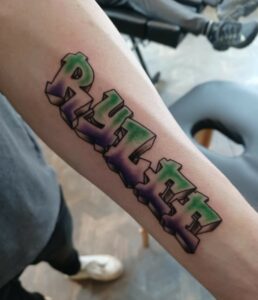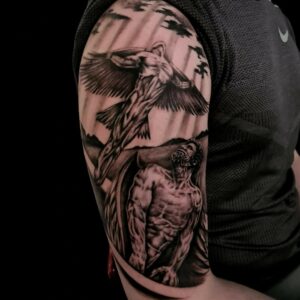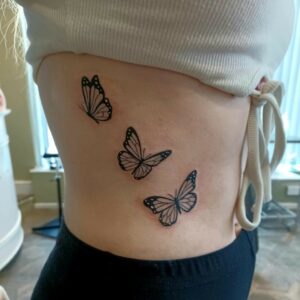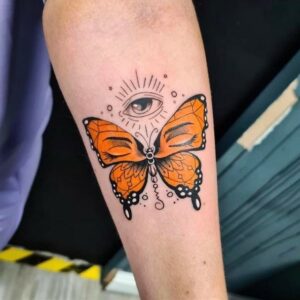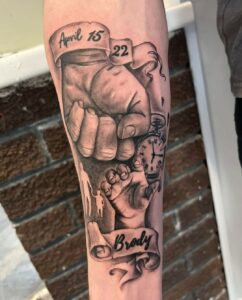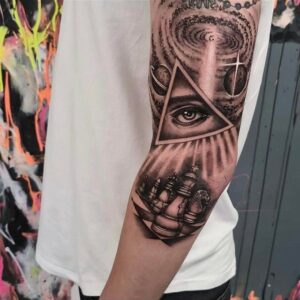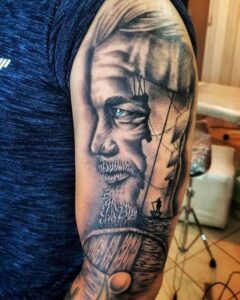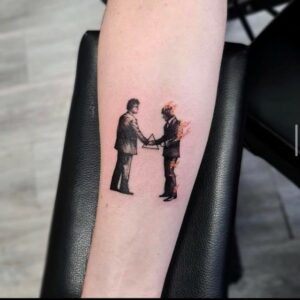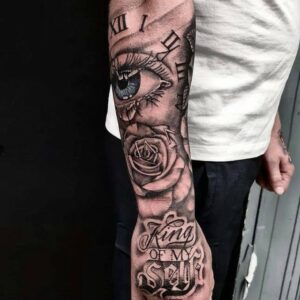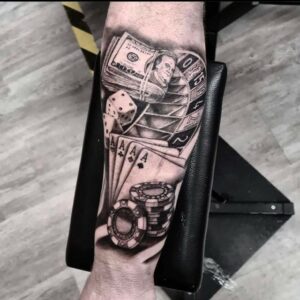Embarking on the journey of getting a tattoo is thrilling, but it’s also a commitment that demands a bit of know-how. We’re here to guide you through what to do when getting inked, ensuring your experience is as smooth as the lines of your new tattoo.
Navigating the world of tattoos can be tricky, but with nearly one-third of Americans flaunting at least one, it’s clear they’re more than just a trend. They’re a personal statement, a work of art etched into your very skin. So, before you dive in, let’s talk tattoo etiquette and prep – the essentials for a memorable and regret-free tattoo experience.
There are many tattoo shops in Liverpool but feel free to contact us to see if we can help you with your next tattoo
Walk-in Tattoo or Pre-booked
When considering getting a tattoo, one of the first decisions is whether to opt for a walk-in session or to book an appointment in advance. Each approach has its own set of pros and cons. Walk-in tattoos offer spontaneity and are ideal for those seeking a more impulsive or immediate tattoo experience. They’re particularly suitable for simpler designs that can be done quickly. However, walk-ins may involve longer wait times and a limited selection of artists, potentially affecting the quality or personalization of the tattoo. On the other hand, booking an appointment allows for thorough preparation and time to consider the design, ensuring a more personalized and considered choice. It also guarantees time with a preferred artist, which can significantly enhance the quality and satisfaction with the final result. The downside is the lack of immediate gratification and, in some cases, a lengthy wait period before the appointment date, especially if the artist is in high demand. Therefore, the choice between a walk-in and booking depends largely on the individual’s priorities, whether they value spontaneity and immediacy or personalization and preparation.
Consultation and Design
Once a suitable artist is identified, scheduling a consultation is the next stride towards our tattoo journey. This is the prime opportunity to relay our preferences, discuss the design, and absorb the artist’s suggestions. A successful consultation revolves around effective communication, where questions about their experience, sterilization procedures, and aftercare instructions are encouraged.
During the consultation, being clear and articulate about what we want allows the artist to create a custom design tailored to our desires. It’s the moment to bring forward any reference images or ideas we’ve gathered, ensuring the final design captures the essence of our intentions.
Decide on Placement and Size
The placement and size of our tattoo are pivotal decisions that impact both the aesthetic appeal and personal comfort. We must consider how the tattoo will integrate with our body’s shape and any social or professional constraints that might influence visibility. It’s imperative to wear appropriate attire that grants easy access to the area we intend to get tattooed, ensuring a smooth and unrestricted session.
Deciding on the size of the tattoo also has its implications. Larger pieces require longer sessions and possibly multiple visits, while smaller tattoos might be accomplished in a single appointment. Throughout this process, we must remain flexible and open to the artist’s expert recommendations on the most suitable placement and size for the chosen design.
Prepare Mentally and Physically
Preparing for a tattoo involves more than just deciding on a design – it’s about ensuring we are ready both mentally and physically. Turning up inebriated or under the influence is a definite no-go, as it can adversely affect our pain tolerance and the healing process. Arriving well-hydrated, with a full stomach and a clear head, is the best way to face the tattooing experience.
We also need to prep our skin but must refrain from applying numbing cream unless directed otherwise by the artist. It’s beneficial to have a good night’s sleep before the appointment and to carry something to distract ourselves during the session. Taking breaks is perfectly acceptable when needed, and it helps us maintain composure and comfort throughout the process.
What to Expect During the Tattoo Process
Preparing for the Tattoo Session
When it’s time for your tattoo session, preparation is key. Shaving the area where you’ll be tattooed is essential, ideally starting 2-3 times per week before your appointment. This preps the skin for the session, providing a clean canvas. Staying hydrated is crucial too. Aim to drink eight 8oz glasses of water in the 24 hours leading up to your tattoo to ensure your skin is in optimal condition. Hydrated skin accepts ink better, making the session smoother for both you and the artist.
The Tattooing Process
As you settle into the artist’s chair, the process starts with skin cleaning and applying a stencil of your tattoo design. It’s our job to maintain the highest standards of cleanliness throughout, laying the groundwork for a brilliant result. The tattoo machine, equipped with sterile needles, will then trace the stencil lines, embedding the ink beneath the skin’s surface. During this time, we’ll remain vigilant, making sure every line and shade contributes to the masterpiece that’ll adorn your body.
Dealing with Pain and Discomfort
Pain is a subjective part of the tattooing experience. Areas with less fat or closer to bone tend to be more sensitive. That being said, discomfort is temporary and manageable. We recommend avoiding tattoo sessions during your period, as skin sensitivity may increase. Breathing techniques and breaks can also help manage pain. We’re here to ensure you’re as comfortable as possible, so don’t hesitate to communicate any concerns you might have.
Taking Care of Your New Tattoo
The journey doesn’t end when the last drop of ink settles. Aftercare is vital. Expect us to apply a thin layer of ointment to protect against bacterial infections and then cover the area with cling film or a similar protective layer. It’s the onset of a healing process that demands attention to maintain the vibrancy and clarity of your new tattoo.
It’s imperative to follow the aftercare instructions we provide, keeping the tattoo clean and well-moisturized, ensuring a swift and effective healing process. Taking care of your tattoo is a testament to the respect you have for the art and for your own body as its lifelong canvas.
Aftercare Tips for Healing and Maintenance
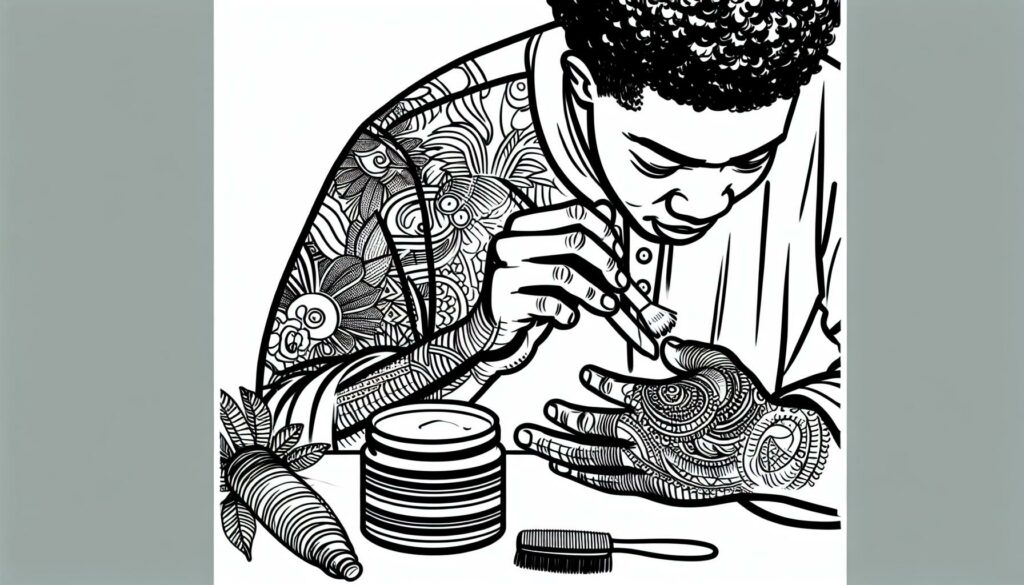
Follow the Tattoo Artist’s Instructions
After investing time and creativity into getting our new tattoo, it’s crucial to heed the specific aftercare advice provided by our artist. Every artist may have a slightly different set of guidelines to ensure optimal healing, but there are some commonalities. They’ll generally advise us to leave the bandage on for a set period, ranging from two to four hours, to protect against external contaminants. If our artist has used a more modern, clear bandage like Saniderm, we might be told to leave it on for three to five days. Trusting our artist’s expertise is vital—as they know best how to prevent infection and ensure that our tattoo heals with the sharpest quality.
Keep the Tattoo Clean and Moisturized
It’s paramount for us to maintain the cleanliness and hydration of our tattoo during the healing process. We should be cleaning the tattooed area, usually twice daily with a product suited for tattooed skin, such as an unscented antibacterial soap. Patting the area dry with a clean towel instead of rubbing helps to avoid irritation. Following the cleaning routine, we will apply a thin layer of fragrance-free moisturizer—a critical step as it keeps the tattooed skin supple and aids in the healing process. Products with alcohol should be avoided since they can dry out the skin, potentially leading to complications.
Avoid Certain Activities and Environments
We must remember that our tattoo is an open wound and it needs time to heal. That’s why it’s essential to sidestep activities that may expose the tattoo to bacteria or that can slow down the healing process. This includes avoiding swimming pools, hot tubs, and natural bodies of water like the ocean for at least two weeks post-tattooing. Excessive sweating from intense workouts or sports can also be harmful, so we’ll want to tone down our physical activities during the initial healing phase.
Monitoring for Signs of Infection
While we take all necessary precautions, it’s necessary to observe our tattoo for any signs that may indicate an infection. Symptoms like excessive redness, swelling, a foul odor, or continuous pain should not be taken lightly. If we notice any of these, it’s best to seek medical attention promptly. Keeping a vigilant eye on our tattoo’s healing process will not only help in preventing potential complications but also ensure the long-term vibrancy and health of our new piece of art.
Long-Term Tattoo Maintenance
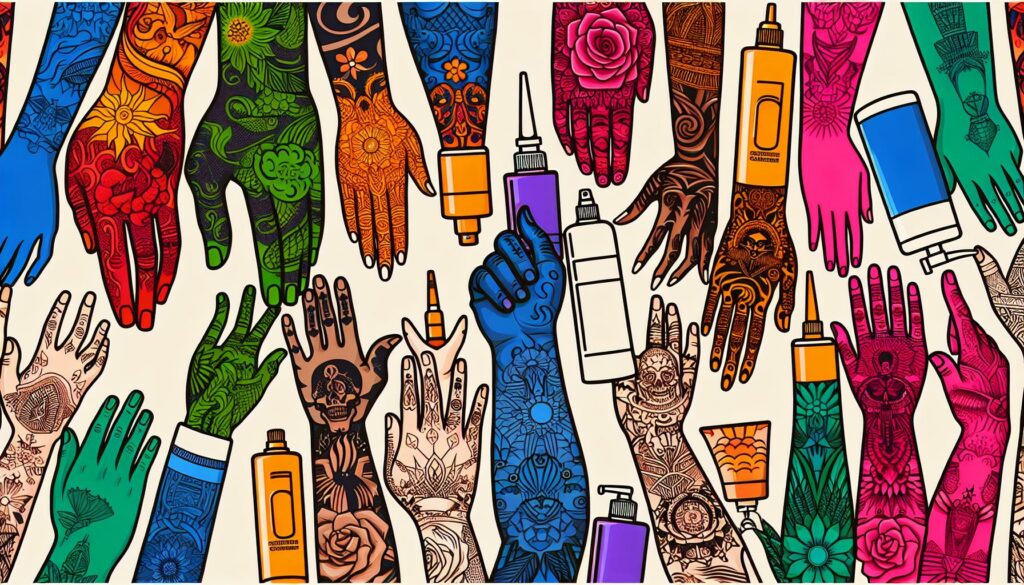
Maintaining the vibrancy and clarity of our tattoos is a long-term commitment. Here’s how we can protect our ink and ensure it ages gracefully.
Protecting Your Tattoo from the Sun
To ensure our tattoos stay sharp and vibrant, it’s crucial to shield them from the sun’s harsh rays. Sun exposure can significantly fade tattoo ink over time. We should apply a broad-spectrum sunblock of SPF 30 or higher to our tattoos – especially during the sunniest parts of the day. If possible, we ought to wear clothing that covers our tattoos when spending extended periods outside. Remember that even on cloudy days or through car windows, UV rays can still cause fading so it’s always best to stay protected.
Touch-ups and Additional Work
Even with exceptional care, some tattoos may require touch-ups to maintain their original splendour. This is perfectly normal. Over the years, certain colours may fade or outlines could blur slightly. Touch-ups revitalise the tattoo, bringing back the sharpness and brightness. Should we desire changes or additions, we can consult with our tattoo artist to discuss the possibility of alterations or expansions. It’s advisable to visit the same artist who did the original piece, as they’ll be best acquainted with the work and our skin.
Maintaining Proper Skincare
Our skin is the canvas for our tattoos, and like any masterpiece, the canvas must be maintained to preserve the artwork’s quality. Moisturising daily with a fragrance-free lotion helps keep the skin supple and the tattoo looking fresh. Dry skin can lead to faster deterioration of ink. We must also look after our overall skin health with a balanced diet and ample hydration. Keeping our tattoos clean and nourished supports the longevity and brightness of the design, making it stand out for all the right reasons. Regular moisturising and exfoliating to remove dead skin cells can prevent our tattoos from looking dull and can help them look their best year after year.
We’ve armed you with the essentials for a successful tattoo journey. Remember, choosing the right artist and shop is as crucial as the design itself. Our parting advice? Trust the process, care for your new art and embrace the transformation. Tattoos are not just about aesthetics—they’re a rite of passage, a piece of your story etched in ink. So go ahead, make your mark with confidence and watch as your vision becomes a vibrant reality.
Frequently Asked Questions
Do tattoo artists prefer clients who don’t talk much?
Artists appreciate clients who stay calm and minimise movement during the session. If they initiate conversation, feel free to engage, but if they’re focused, allow them to work without interruption. Avoid staring at the tattoo as it can add pressure.
How painful is it to get your first tattoo?
The level of pain experienced during a first tattoo can vary, but it often feels similar to a cat scratch or a mild sunburn. The pain is subjective and depends on individual pain threshold and tattoo placement.
What are the do’s and don’ts before getting a tattoo?
Do hydrate well before your session and don’t consume alcohol for 24 hours prior. Do not shave the tattoo area before your appointment. Avoid aspirin or blood thinners before getting tattooed; some pain relievers are acceptable, but consult the artist.
What behaviours bother tattoo artists the most?
Tattoo artists get annoyed when clients fail to trust their expertise, schedule tight post-appointment plans, or expose the fresh tattoo to unsuitable environments like the beach. Being intoxicated or ignoring the artist’s advice can also disrupt the tattooing process.
Where on the body does getting a tattoo hurt the least?
The least painful tattoo spots are typically areas with more fat, fewer nerve endings, and thicker skin. Common low-pain areas include the outer forearm, thigh, and upper arm. Always consider both comfort and personal preference when choosing tattoo placement.


